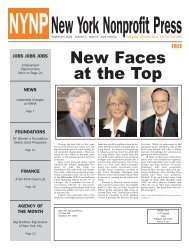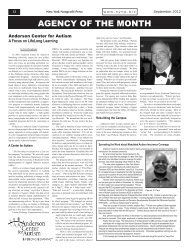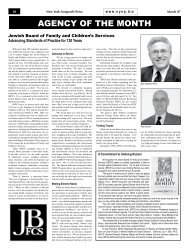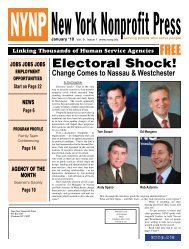March Edition 2011 - New York Nonprofit Press
March Edition 2011 - New York Nonprofit Press
March Edition 2011 - New York Nonprofit Press
You also want an ePaper? Increase the reach of your titles
YUMPU automatically turns print PDFs into web optimized ePapers that Google loves.
14 <strong>New</strong> <strong>York</strong> <strong>Nonprofit</strong> <strong>Press</strong> www.nynp.biz <strong>March</strong> <strong>2011</strong><br />
AGENCY OF THE MONTH<br />
Life’s WORC<br />
Living with Dignity, Growing with Pride<br />
Life’s WORC, established in 1971, traces<br />
its roots directly back to Willowbrook. Founder<br />
Vicki Schneps’ daughter Lara lived there. And,<br />
both Schneps and the agency itself have had a<br />
long and close relationship with Geraldo Rivera,<br />
whose investigative reports brought the plight of<br />
Willowbrook residents to the public eye. The<br />
first Life’s WORC home, whose residents all<br />
came from Willowbrook, is named for Rivera and<br />
was created with funding from the famous Willowbrook<br />
concert held by John Lennon.<br />
This year, as the agency celebrates its 40th<br />
anniversary, Life’s WORC provides residential<br />
care for over 200 individuals with developmental<br />
disabilities who live in 36 separate homes<br />
throughout Queens, Nassau and Suffolk. Like<br />
other community-based agencies created in the<br />
wake of de-institutionalization, Life’s WORC<br />
has evolved far beyond just residential programs.<br />
The agency also serves more than 1,000<br />
individuals – both its own residents and others<br />
living at home with their families -- through a<br />
series of programs including Medicaid service<br />
coordination, day habilitation, recreation, employment<br />
services and more.<br />
With a budget of over $40 million and more<br />
than 800 employees, Life’s WORC also faces<br />
complex operational and management challenges<br />
– particularly at a time when government is<br />
cutting back on its funding to support services.<br />
However, Peter Smergut, who has served as Executive<br />
Director for the past 16 years, believes<br />
that the agency’s strong culture of high quality<br />
care – maintained through an elaborate system<br />
of “Value Surveys”, employee and supervisor<br />
evaluations, and performance-based compensation<br />
-- will enable Life’s WORC to ride out<br />
these difficult times. (See box on page 15.)<br />
Residential Care<br />
Over the past 40 years, Life’s WORC has<br />
steadily expanded the number of residential opportunities<br />
it offers to individuals with disabilities.<br />
After opening the Geraldo Rivera Home in<br />
Little Neck in 1977, the agency grew to a full<br />
dozen residential programs by the mid-1990s.<br />
With implementation of the State’s <strong>New</strong> <strong>York</strong><br />
State Cares program, the pace of expansion<br />
picked up rapidly, tripling Life WORC’s residential<br />
capacity to a total of 36 homes over the<br />
next 15 years.<br />
The agency’s residential programs serve<br />
people with a wide range of developmental<br />
disabilities. It continues to be home for over<br />
33 people who were once residents of Willowbrook.<br />
<strong>New</strong>er residential opportunities generally<br />
accommodate individuals whose families are<br />
no longer able to care for them at home. The<br />
Westbury Home, which houses four young men<br />
and two young women, opened in 2008. Five<br />
of the residents, who previously lived at home<br />
with their families, had effectively grown-up<br />
together while attending the same day school<br />
and programs. “They are lifelong friends,” says<br />
Program Manager Tara Jones Brooks.<br />
Person Centered Planning<br />
Residential opportunities are only one element<br />
of services that people with disabilities<br />
require. In addition to basic shelter and care,<br />
residents want to live as independent and productive<br />
a life as possible consistent with each<br />
individual’s abilities. And, Life’s WORC is<br />
dedicated to supporting those aspirations.<br />
“We are very committed to Person Centered<br />
Planning (CPC). It’s evident in the quality<br />
of life that our people lead,” says Smergut.<br />
The CPC philosophy is intended to ensure that<br />
each person receives the supports that they need<br />
to achieve their own personal goals. In 1999,<br />
Life’s WORC created a full-time staff position<br />
dedicated to the development of person centered<br />
planning efforts. It offers a six-day PCP certification<br />
course for its own staff as well as other<br />
individuals and provider agencies.<br />
Individuals in Life’s WORC residences participate<br />
in a broad range of habilitation, educational,<br />
employment and recreational programs.<br />
“All of the Westbury House residents attend<br />
programs,” explains Jones Brooks. Plus, most of<br />
them also have jobs in the community. “Tommy<br />
works at Wendy’s. James works at AHRC. Brett<br />
works at McQuade’s Café and Meghan works in<br />
the Half Hollow Hills Library.”<br />
After a hard day’s work, residents also<br />
need to play. “They go to Club 21 for bowling<br />
and to a Friday night drop-in with karaoke and<br />
a lot of other activities,” says Jones Brooks. “A<br />
lot of them also take Saturday classes at Nassau<br />
Community College. They do ‘sled hockey’<br />
with practice on Tuesday and Saturday mornings.<br />
Brett’s dad is the coach.”<br />
However, an inividual’s yearning for personal<br />
fulfillment can often go beyond these<br />
group activities, explains Smergut. For example,<br />
Steven Montfisten, a resident at the Life’s<br />
WORC Dix Hills home, lives with a severe<br />
speech impediment caused by traumatic brain<br />
injury following a childhood car accident. While<br />
Montfisten has trouble getting words out verbally,<br />
he has had no trouble getting them down<br />
on paper. The 27-year-old has written hundreds<br />
of poems expressing his feelings about a wide<br />
range of topics. Now, with the help of Life’s<br />
WORC Assistant Director Darrien Carlson and<br />
Psychology Program Director Brian Goldman,<br />
Montfisten has achieved his lifelong dream of<br />
hearing his words recorded to music. Producer<br />
Will Burton arranged for a number of performers<br />
to record lyrics written by Montfisten – now<br />
known professionally as “The Chosen One”.<br />
Montfisten is not the only Life’s WORC<br />
resident finding self-expression through music.<br />
Two years ago, the agency<br />
launched its Life’s Connections<br />
through Music<br />
program, which provides<br />
interested individuals with<br />
the opportunity to play an<br />
instrument and/or sing with<br />
professional performers.<br />
The program includes a<br />
full-fledged “talent search”<br />
and culminated in a November<br />
16th concert at the<br />
Bellmore Theater, featuring<br />
31 performers from Life’s<br />
WORC and other agencies.<br />
For many people, establishing<br />
personal relationships<br />
– including finding<br />
that special someone – is a<br />
particularly important life<br />
goal. “They want to date,”<br />
says Smergut. Making that<br />
happen for individuals with developmental<br />
disabilities can be a challenge. Introductions<br />
through Life helps people meet each other in a<br />
relaxed and supportive atmosphere. Last August,<br />
the agency hosted its second “speed dating”<br />
event which brought together 40 individuals<br />
from Life’s WORC as well as the Epilepsy<br />
Foundation of Long Island and YAI. The event<br />
had a Luau Night theme, complete with hula lessons,<br />
tropical fruit salad and punch. During the<br />
second half of the evening, each person had an<br />
opportunity to speak with twenty new people for<br />
six minutes each. Afterwards, they were given<br />
an “interest sheet” to check off the names of<br />
those individuals whom they would like to get<br />
to know better. By night’s end, 18 new matches<br />
Peter Smergut<br />
had been made. Another was scheduled for<br />
February.<br />
Having a home of their own -- and living<br />
independently – is the ultimate dream for many<br />
individuals. Life’s WORC is helping several<br />
residents to achieve that dream through use of<br />
Individualized Supports and Services (ISS).<br />
“We have one young woman who had been<br />
living at home with her mom and dad,” says<br />
Bonnie Inderjit, Director of At-Home Residential<br />
Services. “She has a daughter of her own.<br />
Now she is able to live in an apartment with her<br />
daughter. She does need help and she gets supports.”<br />
Other individuals have begun to utilize<br />
Personal Resource Accounts (PRAs) through<br />
which they can decide on the specific services<br />
they need and then select and pay for a provider.<br />
Music is just one of the ways in which Life’s WORC assists individuals to<br />
find self-expression.<br />
“We have two people in our programs who are<br />
on demonstration grants,” says Smergut. “They<br />
hire a person who works with them on employment.<br />
If they aren’t happy with that person, they<br />
can find someone else.”<br />
In-Home Supports<br />
The newest Life’s WORC residential program,<br />
a six-bed IRA in Wantagh which opened<br />
in April of 2010, may be the agency’s last…<br />
at least for a while. State budget constraints<br />
have put a hold on approvals for new residential<br />
programs by the NYS Office for People with<br />
Developmental Disabilities (OPWDD). “There<br />
is really no new residential development, other











